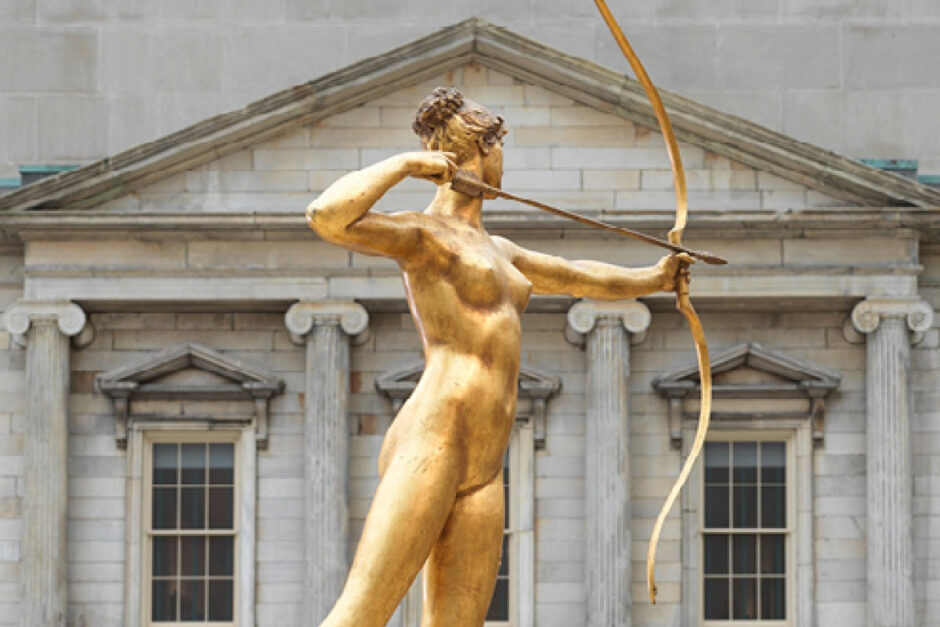 This fall, The Metropolitan Museum of Art’s iconic American Wing will celebrate its centennial with a series of exhibitions and reinstalled galleries. Since its founding in 1924, the curatorial department has expanded its collecting strategy to include a wider array of work from the mid-17th to the mid-20th century, including select contemporary expressions, by makers from across North America. The American Wing at 100 provides visitors with the opportunity to experience a broad scope of the wing’s current holdings, presented in fresh arrangements with new interpretive frameworks. Audio commentaries and a virtual video representing multiple perspectives, from curators to community partners, will further enhance and enrich visitors’ experience. The overall reinstallation will be informed by expansive scholarship and a range of voices related to the ongoing redefinition of a broadly conceived idea and understanding of American art.
This fall, The Metropolitan Museum of Art’s iconic American Wing will celebrate its centennial with a series of exhibitions and reinstalled galleries. Since its founding in 1924, the curatorial department has expanded its collecting strategy to include a wider array of work from the mid-17th to the mid-20th century, including select contemporary expressions, by makers from across North America. The American Wing at 100 provides visitors with the opportunity to experience a broad scope of the wing’s current holdings, presented in fresh arrangements with new interpretive frameworks. Audio commentaries and a virtual video representing multiple perspectives, from curators to community partners, will further enhance and enrich visitors’ experience. The overall reinstallation will be informed by expansive scholarship and a range of voices related to the ongoing redefinition of a broadly conceived idea and understanding of American art.

The American Wing at 100 is made possible by the Jane Parsons Klein Fund.
Additional support is provided by the Terra Foundation for American Art.
“Over the last 100 years, The Met’s American Wing has continued to evolve and transform, expanding to encompass an ever-broadening concept of American art,” said Max Hollein, The Met’s Marina Kellen French Director and Chief Executive Officer. “The exhibitions and displays offered this year present both a compelling and comprehensive view of the wing’s growth over the past century, and a deep dive into definitions of American art, identity, and place.”
Sylvia Yount, Lawrence A. Fleischman Curator in Charge of the American Wing, said: “The centennial is more than a retrospective moment; it is a chance to consider how the wing’s evolution mirrors increasingly fluid and nuanced understandings of what it means to be American, both historically as well as today.”
New Interpretive Frameworks
To welcome and reintroduce visitors to the American Wing in its 100th year, critical entry points to the first-floor galleries (723, 730, and 731) have been reinstalled to display multilayered works from across the collection. Arranged in thematic contexts of “origin stories”—or founding narratives—of American art, design, and culture, these galleries also highlight the intentional expansion of the wing’s holdings to include works produced outside the boundaries of the United States.
On mezzanine level 2A, two reinstalled galleries (717 and 719) offer new displays of 18th-century painting, sculpture, works on paper, and decorative arts—with strategic contemporary interventions—exploring aesthetic and sociopolitical issues of the Atlantic world of ongoing resonance.
The wing’s second floor showcases the broadest transformation, beginning with
The Calculated Curve: Eighteenth-Century American Furniture, a reimagining of the wing’s Anthony W. and Lulu C. Wang Galleries (747–749 and 751–753), which opened in April. This reinstallation elevates a pivotal moment in American furniture design—from 1720 to 1770—and encourages closer looking at materials and forms as well as an understanding of furniture’s sensuality and ergonomics. Featuring iconic American pieces from the wing’s founding collection and beyond, the installation offers a counterpoint to the contextual displays of furniture on view in the period rooms.
Finally, the remainder of the second-floor galleries (755–772), reopening in early November, will highlight well known and recently acquired painting and sculpture from the late 18th, 19th, and early 20th centuries, newly recontextualized and interpreted through relevant lenses—including identity, place, and time—as well as through cultural frameworks inspired by influential world’s fairs.
——————
Recent Acquisitions and Exhibitions
To further mark its centennial, the American Wing will display a number of major works recently added to the collection, including the monumental three-part Tiffany Studios Garden Landscape Window for Linden Hall (1912), designed by Agnes Northrop, which will be installed this fall in the south end of the wing’s destination Charles Engelhard Court. In addition, Jacques Amans’s Bélizaire and the Frey Children—one of the rarest and most fully documented American portraits of an identified Black individual depicted with the family of his enslaver—will be featured in a new display focused on diverse representations of cultural hybridity. Also newly on view in the Henry R. Luce Center for the Study of American Art is a carved wood carousel horse, created by D.C. Müller & Bro. of Philadelphia. Colorfully painted to accentuate the animal’s physical and behavioral traits, this appealing sculpture joins the wing’s growing collection of vernacular objects.
The wing’s Wolf North gallery currently showcases the recent acquisition of drawings by the early 20th-century Yankton Dakota artist Mary Sully in the first solo exhibition of her art, Mary Sully: Native Modern.
Another special centennial installation—A Decade on Paper: Recent Acquisitions, 2014–2024—is now on view in the changing gallery of The Henry R. Luce Center for the Study of American Art, on the wing’s east mezzanine. Highlighting a wide range of graphic production acquired over the past 10 years, the exhibition underscores the renewed attention to the collecting and presentation of works on paper by both well-known and historically understudied figures—including women and artists of color—from diverse communities and across a broad geographic range. The display features thematic groupings of figure studies, landscapes, and still lifes that encourage fresh considerations of the social, political, and economic conditions in which they were produced, as well as their ongoing relevance.
——————
Important Loans
In addition to works from the American Wing’s extensive collection of art and design, the centennial presentation will feature select works from The Met’s Department of Modern and Contemporary Art in a new display focused on “multiple modernisms” (Gallery 757). These Met works will be presented in dialogue with key loans from private collections that reveal the cultural fascination with Black and Indigenous communities by White, Black, and Brown artists between the 1920s and 1940s. Another special highlight is the two-year loan from the Art Bridges Foundation of Henry Ossawa Tanner’s iconic The Thankful Poor—one of only two Black genre subjects painted by the leading early-20th-century African American artist. Displayed and interpreted in the context of the 1893 Columbian Exposition—also known as the White City, held in Chicago—the painting raises questions about race, faith, and representation in late-19th-century American art and culture that continue to resonate today.
——————
About the American Wing at The Met
Since its establishment in 1870, The Met has acquired meaningful examples of American art. A separate American Wing to display Euro-American domestic arts of the 17th to early 19th century opened in 1924; painting and sculpture galleries and a skylit courtyard were added in 1980. A major renovation and reinstallation of the wing’s architecture and collection occurred between 2002 and 2012. And, in 2024, the department marks its 100th anniversary with a new reinstallation of expanded collection areas, highlighting its history and ongoing evolution.
Today, the wing’s ever-growing collection comprises some 20,000 works of art by African American, Asian American, Euro-American, Latin American, and Native American makers. These dynamic holdings range from the colonial to early-modern period and include painting, sculpture, drawing, and decorative arts—furniture, textiles, ceramics, glass, silver, metalwork, jewelry, basketry, quill, and beadwork—as well as historical interiors and architectural fragments by highly trained and self-taught artists, both identified and unrecorded.
Monumental sculpture, stained glass, and architectural elements are installed in the Charles Engelhard Court; silver, gold, glass, and ceramics on the courtyard balconies. Narratives of American domestic architecture and furnishings are explored in 20 historical interiors, or period rooms. Changing rotations of painting, sculpture, works on paper, and textiles in wide-ranging narrative contexts appear throughout the wing.
——————
Credits and Related Content
The American Wing at 100 reinstallation has been initiated and overseen by Sylvia Yount, Lawrence A. Fleischman Curator in Charge of the American Wing at The Met, in collaboration with a range of departmental, Museum-wide, and external colleagues.
The Museum has organized a variety of related art and educational programs, including “Johnny Gandelsman: This Is America,” a solo violin performance of the violinist’s commissioned project, and “A Celebration—The American Wing at 100,” which will engage visitors with programs ranging from art making and gallery chats to artist talks and performances.
———————
Image: The Charles Engelhard Court, The American Wing
———————
Future programming details will be posted on The Met website as they become available.
For more information on the American Wing and related content, please visit the department page: https://www.metmuseum.org/
~~~~~~~~~~~~~~~~~~~~~~~~~~~~~~~~~~~~~~~~
|

AAQ / Resource: Ben Krupinski Builder
===========================================================

AAQ / Resource: Westhampton Architectural Glass
_________________________________________
